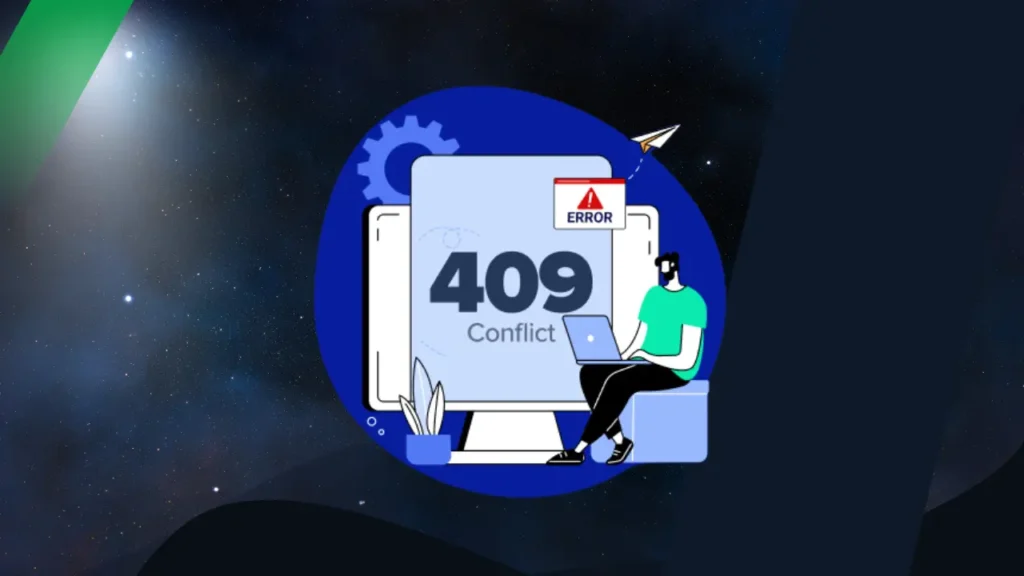What is a 409 Error?
An HTTP status known as “code 409” or “Conflict” denotes a request that conflicts with the server’s current state. Unlike other somewhat simple HTTP errors, the 409 error indicates a more complicated problem that needs to be carefully examined. Usually, this error indicates that a conflict with the resource’s current state prevented the request from being processed.
Common Causes of 409 Error
The root causes of the 409 error are crucial for effective troubleshooting and resolution. Several scenarios can lead to a 409 error:
- Simultaneous Updates
- Version Control Conflicts
- Database Constraints
- API Requests
Simultaneous Updates
When multiple requests attempt to update the same resource simultaneously, a conflict can arise, leading to a 409 error.
Version Control Conflicts
In systems using version control, discrepancies between the updated resource version and the server’s current version can trigger this error.
Database Constraints
Unique constraints or other integrity rules in a database can result in a conflict if a request violates these constraints
API Requests
Mismanaged API calls, where the sequence of operations is not properly handled, can lead to conflicts.
Impact of 409 Error on User Experience
While essential for maintaining data integrity and consistency, the 409 error can significantly impact the user experience if not handled properly. Users might encounter unexpected errors or failures when performing actions, leading to frustration and decreased satisfaction. This can be particularly problematic in high-traffic applications or services where timely and reliable interactions are critical.
Tools for Diagnosing HTTP Errors
Diagnosing a 409 error effectively requires the right set of tools. Developers can utilize several diagnostic tools to pinpoint the cause of the conflict:
Browser Developer Tools
Built-in tools in browsers like Chrome and Firefox provide detailed insights into HTTP requests and responses, helping identify where conflicts occur.
HTTP Debugging Proxies
Tools like Postman and Fiddler allow developers to inspect HTTP traffic and understand the context of the conflict.
Server Logs
Analyzing server logs can provide valuable information about the state of the application and the nature of the conflict.
Resolving 409 Error in Web Development
A 409 Conflict error indicates that a conflict has arisen when processing a request. This can happen for various reasons, but typically, the server can’t fulfill the request because the resource’s state is being modified. Here’s how to tackle these errors:
General Steps for Resolution:
Identify the Conflict
Was there a simultaneous edit attempt? Outdated information used? Or a violation of database rules? Understanding the root cause is crucial.
Take Corrective Action
Depending on the cause, you can:
- Refresh the page to retrieve the latest version.
- Coordinate updates with others to avoid conflicts.
- Modify your request to comply with database constraints.
Seek Additional Help (Optional)
For complex systems, consult the documentation or contact technical support for further guidance.
Advanced Troubleshooting:
Pinpointing the Conflict: Once you suspect the cause, delve deeper to identify the specific element in the request causing the issue.
Request Review: Carefully examine the data being sent in the request and compare it with the current state of the resource on the server. This helps identify discrepancies leading to the conflict.
Conflict Resolution Strategies: Implement mechanisms within your application to handle conflicts gracefully. This might involve:
Retry Mechanisms: After a 409 error, automatically retry the request with a slight delay, allowing time for the conflicting situation to be resolved.
Optimistic Concurrency Control (OCC): This technique allows concurrent edits but implements checks to identify and handle conflicts when saving changes. Data versions and timestamps are often used for conflict detection.
Merging Changes: In specific scenarios, merging or combining conflicting changes to achieve a unified result might be possible. However, depending on the context, this requires careful consideration and user involvement.
Resolving 409 Errors in REST APIs
In REST API development, the 409 error is a common issue due to the stateless nature of HTTP and the asynchronous nature of modern applications. Here are specific steps to resolve 409 errors in REST APIs:
Optimistic Concurrency Control: Implement mechanisms that check for the current state of the resource before updating it.
Versioning: Use resource versioning to ensure that updates are only applied to the correct version of the resource.
Conflict Resolution Strategies: Develop strategies for merging conflicting changes or notifying users of conflicts to enable manual resolution.
Handling 409 Error in Database Transactions
When dealing with database transactions, resolving a 409 error often involves ensuring that transactions do not violate database constraints:
- Use Unique Constraints Wisely
- Transaction Management
- Retry Mechanisms
Best Practices to Prevent 409 Error
Implementing Proper Version Control
Version control is essential for preventing conflicts that lead to 409 errors. Here are the best practices for implementing version control:
Use Version Identifiers:
Assign version identifiers to resources to track changes and detect conflicts.
Implement Version Checks:
Before updating a resource, check its current version to ensure compatibility with the requested changes.
Ensuring Database Integrity
Maintaining database integrity is key to preventing 409 errors caused by conflicting database operations:
Unique Constraints:
Use unique constraints to prevent duplicate entries and ensure data integrity.
Normalization:
Design normalized database schemas to minimize redundancy and potential conflicts.
Integrity Checks:
Implement integrity checks to validate data before committing transactions.
Using Optimistic Concurrency Control
Optimistic concurrency control is an effective strategy for managing conflicts in web applications:
E-tags and Versioning:
Use E-tags or version numbers to track resource changes and prevent conflicts.
Conflict Detection:
Detect conflicts by comparing the current state of the resource with the state at the time of the request.
Conflict Resolution:
Develop strategies for resolving detected conflicts, such as merging changes or rejecting conflicting updates.
Case Studies
Real-Life Examples of 409 Error and Resolutions
Examining real-life examples can provide valuable insights into handling 409 errors effectively:
E-commerce Platform:
An e-commerce platform experienced 409 errors due to concurrent order updates. By implementing optimistic concurrency control and versioning, they were able to resolve these conflicts.
Collaborative Editing Tool:
A collaborative editing tool faced 409 errors when multiple users edited the same document simultaneously. They addressed this by introducing conflict resolution mechanisms that allowed users to merge changes or select preferred updates.
We can prevent larger issues by
- Early Detection
- User Notification:
- Scalability Considerations
Advanced Troubleshooting
Using Logging to Identify Conflict Sources
Logging is an invaluable tool for identifying the sources of conflicts that lead to 409 errors:
- Detailed Logs
- Analyze Patterns
- Trace Requests
Debugging Concurrent Requests
Debugging concurrent requests requires a systematic approach:
- Identify Concurrent Operations
- Isolate Requests
- Test Scenarios
Analyzing Server-Side Logs
Server-side logs provide a wealth of information for diagnosing and resolving 409 errors:
- Error Logs
- Transaction Logs
- Performance Metrics
Optimizing Your Web Application
Optimizing API design can help prevent 409 errors:
Idempotency:
Ensure that API operations are idempotent, meaning that repeated requests produce the same result without causing conflicts.
Atomic Operations
Design API endpoints to perform atomic operations that complete entirely or not at all, preventing partial updates that can lead to conflicts.
Request Sequencing
Implement mechanisms to sequence requests properly, ensuring that they are processed in the correct order.
Enhancing Client-Side Request Management
Managing requests effectively on the client side can reduce the likelihood of 409 errors by
- Batch Requests
- Retry Strategies
- Client-Side Caching
Using Middleware to Handle Conflicts
Middleware can play a crucial role in handling conflicts and preventing 409 errors:
- Conflict Detection Middleware:
- Retry Middleware:
- Conflict Resolution Middleware
Developer Tools and Resources
Recommended Tools for Managing HTTP Errors these tools can help developers manage and resolve HTTP errors, including the 409 error is
Postman: A powerful tool for testing and debugging HTTP requests.
Fiddler: A web debugging proxy that captures and analyzes HTTP traffic.
Loggly: A cloud-based log management service that helps analyze server logs and identify errors.
Community Resources and Support Forums
Engaging with the developer community can provide valuable insights and support this popular platform for developers to ask questions and share solutions
- Stack Overflow
- GitHub Issues
- Developer Forums
Conclusion
Even though it can be difficult, the 409 error is crucial for guaranteeing data consistency and integrity in online development. Through a comprehensive diagnosis, effective resolution, and implementation of preventive measures, developers may mitigate the effects of this issue on user experience while preserving the dependability of their apps. Importantly, not only may 409 errors be fixed using best practices and appropriate tools, but online applications can also be significantly improved, becoming more scalable and resilient.
Frequently Asked Questions
What is a 409 error?
A 409 error, or Conflict error, occurs when a request conflicts with the current state of the server, often due to simultaneous updates or version control issues.
How can I diagnose a 409 error?
Use tools like browser developer tools, HTTP debugging proxies, and server logs to identify the source of the conflict and understand its context.
What are the common causes of 409 errors?
Common causes include simultaneous updates, version control conflicts, and database constraints that result in conflicting operations.
How can I prevent 409 errors in my web application?
Implement proper version control, maintain database integrity, and use optimistic concurrency control to prevent conflicts that lead to 409 errors.
What are some best practices for handling 409 errors in REST APIs?
Use optimistic concurrency control, implement versioning, and develop conflict resolution strategies to handle 409 errors in REST APIs effectively.
Can middleware help in resolving 409 errors?
Yes, middleware can detect and handle conflicts, retry requests, and provide automated conflict resolution, reducing the impact of 409 errors on your application.



